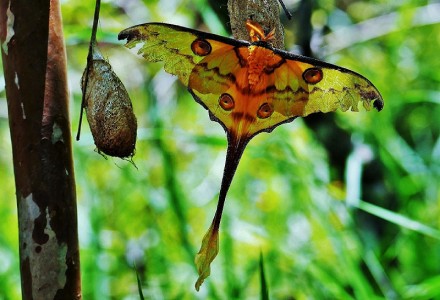
Photographer: Sue Roehl
CC License: https://bit.ly/1ryPA8o
Comet Moth Facts
- The term of Comet Moth serves as only one of the common names for this incredibly beautiful variety of Lepidoptera. The insect also goes by the alternate common name of the Madagascan moon moth. Its scientific name, meanwhile, is Argema mittrei.
- Regardless of which term one uses to refer to it, the species remains a remarkable one. This further holds true for several reasons. Chief among them, however, is the simple fact that it currently ranks as one of the largest of its kind known to man.
- This first official recognition of this astonishing invertebrate as a separate and distinct species occurred in 1847. The noted French entomologist, Felix Edouard Guerin-Meneville had the distinction of making that entry into the annals of science.
- For the moment, the population of the gorgeous Comet Moth appears to be stable. Sadly, though, part of that situation stems from its being commonly bred in captivity. The IUCN nevertheless currently has no listing for it on the organizations Red List.
- It must nonetheless be considered to be at risk. Despite its popularity in captivity, its natural range remains quite restricted. Due to this simple fact, two factors threaten it the most. These consist of habitat loss and the ongoing effects of climate change.
Related Articles
Vampire Moth Cecropia Moth Plume Moth
Comet Moth Physical Description
It’s worth noting, first of all, that the Comet Moth impresses for more than just its sheer size. That statistic does, however, bear elaborating on. Although the species ranks as large overall, though, it also displays a marked degree of the trait of sexual dimorphism.
In its particular case, this characteristic manifests itself in terms of the males growing significantly larger than the females. An average adult male boasts a wingspan averaging roughly 8 in (20 cm). Even larger individuals have been seen by observers, however.
The females of this arthropod remain significantly smaller, though. More precisely, these rarely attain more than half the size of the males. Though gender-based size differences are common among Lepidoptera, this nonetheless represents a larger than usual degree.
The wings of the Comet Moth also display a bright yellow in color. A unique brownish-orange fringe usually appears along the outside of the wings, though. Lines and spots of the same darker color also frequently appear on the upper side of the wings of the arthropod.
- Kingdom: Animalia
- Phylum: Arthropoda
- Class: Insecta
- Order: Lepidoptera
- Family: Saturniidae
- Genus: Argema
- Species: A. mittrei
Photographer: Frank Vassen
CC License: https://bit.ly/1ryPA8o
Comet Moth Distribution, Habitat, and Ecology
Unfortunately, both for humans and the Comet Moth itself, this truly breathtaking insect possesses an extremely limited habitat range. That’s because, to our knowledge, this stunning insect only lives in the rainforests of the island of Madagascar, in Africa.
More precisely, furthermore, it only seems to inhabit the deepest sections. A somewhat surprising mystery also surrounds the beautiful creature. It lives a primarily nocturnal life, thus its brilliant coloring serves no evolutionary purpose that scientists can determine.
Each female lays between 120-170 eggs after mating, after which she quickly dies. The hatching larvae feed voraciously, primarily on only two specific species of local plants. This trait, however, serves to further increase its currently fragile situation.
The combination of tiny territory range and high dependency on specific plants makes it vulnerable. Further, like many of its relatives, it also remains wholly incapable of feeding, once it emerges from its cocoon. Therefore, its adult lifespan only measures 6-8 days.
The gorgeous Lepidoptera also displays a fascinating trait. The cocoons that it spins for itself develop with numerous holes in it. Experts theorize this is intended to allow water to drain through, given its rather wet habitat, thereby preventing it from drowning.
Species Sharing Its Range
Rosy Periwinkle Fossa Coconut Crab
Check out our other articles on 4 Fabulous Marine Shrimp, Tufted coquette, Isle of Skye, Shameplant, Bowmouth Guitarfish, Red-Tailed Bumblebee, Ring-Tailed Cat, Rainbow Snake

